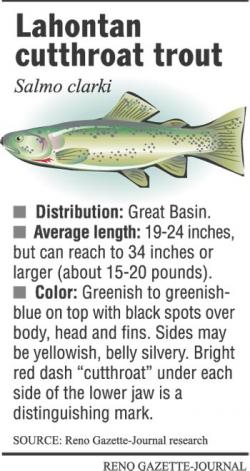Recovery of cutthroat trout focus of Truckee River study
Outcome to direct restoration funds
|
|
||||
A study of the Truckee River’s ecosystem that includes the recovery of native trout was approved Wednesday by a panel of water experts.
The Regional Water Planning Commission agreed to spend up to $248,700 for three years to study the river’s food web and other characteristics that could impact the recovery of Lahontan cutthroat trout.
Information collected could help steer decisions regarding multimillion-dollar river system improvements, experts said.
“This should allow us to maintain the healthiest Truckee River that we can,” said Sudeep Chandra, a lead researcher for the study from University of Nevada, Reno.
The study will employ an emerging scientific methodology used by experts now trying to return mackinaw trout to America’s Great Lakes and also to preserve the population of the world’s largest salmon in the upper watershed of Asia’s Lake Baikal, Chandra said.
On the Truckee River, the study is designed to aid ongoing efforts to restore threatened Lahontan cutthroats, Nevada’s state fish. Cutthroats once flourished throughout the Truckee River, in Lake Tahoe and Pyramid Lake but disappeared decades ago due to dam construction, overfishing and introduction of non-native fish.
Cutthroats have been kept alive through hatchery programs, including one operated by the Pyramid Lake Paiute Tribe.
The new study will involve both a “bottom-up” and “top-down” look at the river ecosystem, Chandra said. The former will examine river characteristics at seven locations between Farad on the Nevada/California border and Pyramid Lake, where the river ends. Factors to be studied include water quality and flow, existing fish habitat, the presence of nutrients and availability of foods such as stone flies.
The “top-down” component will trace movements of cutthroats planted in the river and examine their feeding behavior.
“It’s letting the fish talk to us” and inform researchers about what parts of the river are most favored by cutthroats and why, Chandra said.
“How do food webs, or who eats who, change over time?” Chandra said.
Information collected could help guide decisions about costly river improvement projects, such as the one under way at the McCarran Ranch downstream of Sparks, experts said.
“This gets to the nitty-gritty of what are we doing that has an effect,” said Erik Ringelberg, who will participate in the study on behalf of the Pyramid Lake Paiute Tribe.
The study, Ringelberg said, could “help us direct where we want to spend millions of dollars on restoration.”
Copyright © 2005 The Reno Gazette-Journal
